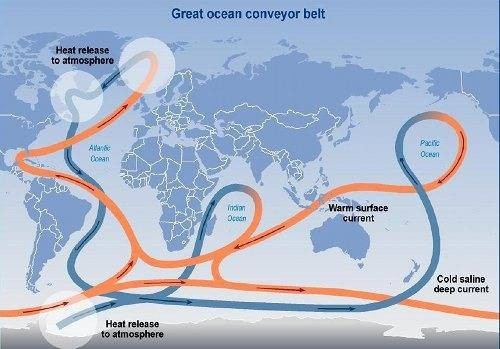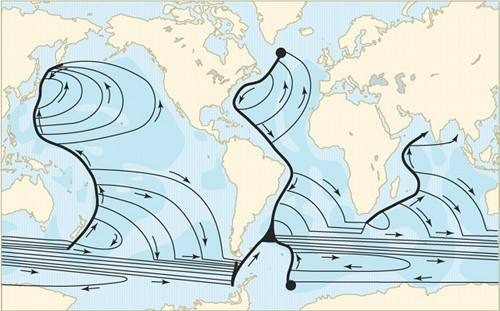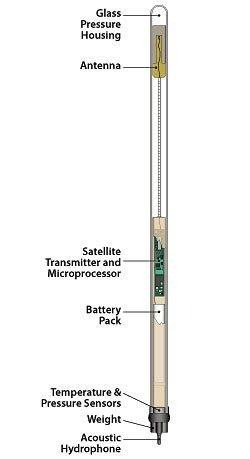The theory of the Great Ocean Conveyor Belt has been demolished
Oceans cover 71% of the Earth's surface, but contain an immeasurable amount of water, or approximately 96.5% of all the water on the planet: a huge reservoir of heat.
The oceans never froze even billions of years ago, when the Sun irradiated the Earth 30 percent less than today, thanks to their mechanism of circulation of currents.
But this is nothing new.
The novelty is that the famous Great Ocean Conveyor Belt, also known as the southern overturning current (MOC - meridional overturning current) or as the Thermoaline Circulation (CPT), the subject of countless television documentaries and science lessons at school and college, it's not quite as simple as scientists believed.
After more than 50 years, the old model of global ocean circulation that predicts a deep Atlantic current flowing beneath the Gulf Stream has been challenged by an army of sensors specifically abandoned in the ocean to be carried by the current beneath the sea surface on deep buoys, leaving an electronic trace of their course.
As shocking as the news was for oceanographers, it was even worse for climatologists who have constructed various climate circulation models. For them it means that all current climate prediction models are completely wrong, starting with those used by the IPCC (Intergovernamental Panel on Climate Change).

In the best known configuration, the so-called "Great Ocean Conveyor Belt" is a colossal underwater river 20 times larger than all the terrestrial rivers put together: it forms in the center of the Pacific ocean, then continues superficially bypassing Australia to the north and the South Africa, it goes up the Atlantic ocean and finally sinks to the height of Greenland, now cold and very salty, ready to return to the Pacific, but this time passing south of Australia. The entire journey takes, it is calculated, 500 years.
According to the best-known models, it was thought to be vulnerable only to variations in the production of fresh water at high latitudes, with a significant injection of non-saline water resulting from the melting of the ice, definitely capable of disrupting the proper functioning of the system. While in normal conditions the conveyor belt was designed to operate constantly and consistently just like a conveyor belt, with the transport of cold water from the equator to the depth and warm water to the poles on the surface. This is why we also speak technically of southern tipping circulation.
M. Susan Lozier of Duke University published an in-depth scientific work in Science on June 18, 2010, the results of which had already been partially disseminated a year earlier in Nature, with the emblematic title of "Demolition of Conveyor Belt "(Science 18 June 2010: Vol. 328. no. 5985, pp. 1507 - 1511).
With a series of studies conducted in recent years he has questioned the conveyor belt paradigm, revealing the vital role of ocean eddy currents and atmospheric currents in establishing the structure and variability of exchange between hot and cold waters in the interior of the oceans. Susan M. Lozier is Professor of Oceanography Physics and President of the Division of Earth and Ocean Sciences at Duke University, a private university with more than 12,000 students founded in 1838, located in Durham, North Carolina (USA).
More than fifty years ago, Henry Melsom Stommel (1920-1992) theorized that water cooled by high latitudes should be carried deep along the western equator and intensified by the surrounding currents.

He assumed that the masses of water formed through a mechanism of deep convection in isolated regions of the North Atlantic and near Antarctica essentially ended up filling the deepest ocean. Stommel hypothesized that, during the transport of these waters into the deep ocean, they subsequently underwent a well-distributed rise to the surface.
Since this rise produces an elongation of the water column which induced a loss of angular momentum, the deep internal waters had to compensate for the loss of flow towards the poles heading towards the regions of greater angular momentum. For this reason, the transport of deep water masses at the equator was limited to the western borders of the basins.
Stommel's theory of ocean overturning has given a structure to oceans, previously considered amorphous in three dimensions: deep waters are carried towards the equator with a constant, continuous intensification by deep western boundary currents coming from their training sites located at high latitudes.
The second major oceanographer who supported this thesis was the famous Wallace "Wally" S. Broecker, professor emeritus in the Department of Earth and Environmental Sciences at Columbia University (New York), one of the most prestigious and famous universities on Earth.

Probably one of the greatest geologists in the world still living who, for over half a century, has been investigating the role of the oceans in climate change. He was among the pioneers in the use of radiocarbon dating and the use of isotopes to monitor historical climate change, and the influence of climate change on polar ice and ocean sediments. It was Broecker himself who coined the term "Great Ocean Conveyor Belt".
But it was Lozier's work that shocked the scientific community.

In his work a large number of underwater buoys (RAFOS – SOund Fixing And Ranging), have been dispersed at a depth of 700 - 1500 meters and have shown that some fundamental assumptions on the structure of the current are wrong. The floating RAFOS are mobile instruments designed to move with the water and keep track of the movements of the ocean current. It appears that 75% of RAFOS escaped the Great Ocean Conveyor Belt and drifted offshore. Only 8% of RAFOS buoys followed the current of the conveyor belt as already published in Nature. RAFOS buoys were designed to measure temperature, salinity and pressure at high depths up to 3,000 meters below the surface of the oceans.

According to Lozier, Broecker's theory on the reversal of the ocean currents, as it is structured, should be considered only as the main agent responsible for the rapid fluctuations of the climate, as experienced during the last glacial period of the Earth.
"Despite the importance of the ocean current reversal theory to the Earth's climate, ... Broecker's work is to be regarded essentially only as an agent of climate change," Lozier says in her review. "Just as Stommel's work gave the spatial structure to the reversal of currents, Broecker provided a temporal context."
Based on her review, oceanographers understood that the transport model with the overturning of sea currents is an oversimplification of the system. But it was believed to be a useful simplification, capable of providing a global ocean transport model of thermal energy. But now it seems that some main characteristics of the conveyor belt have been called into question.
Here is a list of recent discoveries that have shaken the foundations of the conveyor belt theory:
- Most of the subpolar-subtropical exchange in the North Atlantic occurs along paths within the Atlantic itself.
- The Deep Western Boundary Current (DWBC) breaks down into eddies around 11 ° South latitude.
- There is little coherence in transport across the southern hemisphere passing from one spiral reversal to the next.
- The force of the wind, rather than favoring the upward thrust of the water, can play a decisive role in modifying the phenomenon of the reversal of currents.
- Southward transport of deep water at latitude 8 ° South, off the Brazilian coast, has been shown to be entirely due to eddies adhering to the current.
- Deep buoys launched into the Deep Western Boundary Current (DWBC) at latitude 53 ° North, do not follow a constant current, but take multiple paths to the subtropics, including internal paths located away from the DWBC.
- Two further recent studies have shown completely unexpected paths in the northern portion of the oceans.
- A recent study indicates that the southern overturning current (MOC - Meridional Overturning Circulacion) transport in the subtropical North Atlantic is susceptible to variability with loss of warm and salty water in the South Atlantic.
- Various studies demonstrate little or no coherence in circulation at the main stream boundaries of the large conveyor belt and have prompted to control the overturning circulation of the current in the South Atlantic and the subpolar North Atlantic.
- The connection between the phenomenon of the overturning of currents and, above all, the transport of heat from the southern hemisphere from one basin to another can no longer be assumed on an interannual temporal scale (editor's note, that is, it can change everything very quickly).

































